![]() In the first Steiny Road column, I discussed how the work-in-progress opera Gertrude Stein Invents A Jump Early On got started, but merely ticking off the sequence of events leading to the commissioning of the project does not tell the whole story. What I will attempt to ignite in this telling is the elusive spark that erupts when people believe in you enough to stop what they are doing and turn their attention to your project. So this column continues the thread about the importance of community that I presented in the last essay while weaving in the performance aspect.
In the first Steiny Road column, I discussed how the work-in-progress opera Gertrude Stein Invents A Jump Early On got started, but merely ticking off the sequence of events leading to the commissioning of the project does not tell the whole story. What I will attempt to ignite in this telling is the elusive spark that erupts when people believe in you enough to stop what they are doing and turn their attention to your project. So this column continues the thread about the importance of community that I presented in the last essay while weaving in the performance aspect.
Poetry Stages: From Street Corners to Cemeteries
It’s one thing to gather a following for a literary project where your forum could be as simple as a street corner with your listeners leaning in and forming a semi circle about you, the speaker. I have recited my poetry on the street, in National parks, on a ferry from the Isle of Capri to the docks of Naples, bars in Washington, DC, New York, London, restaurants, shopping malls and stores from books to clothing, elementary schools and up the line to universities, libraries including the Folger Shakespeare Library and the Library of Congress, a maximum security prison in Pittsburgh, a church in Florence, a castle in Tuscany, homes for the aged, a cemetery in Prague, but nothing among this long list of experience in presenting my poetry compares with what needs to happen to get an audience for poetry that has been set to music and brought to life by actors moving on a stage.
You might be thinking, hey! This is a no brainer—poets work alone and sure, there’s a big chasm between a poetry reading by a single poet and a fully staged opera. The fact is poets don’t always work alone. As I mentioned in the first Steiny Road essay, I have been thinking about and making small inroads in poetry theater since the mid 1970s.
Mad Martha’s: Expanding the Poetry Landscape
Picture this: 1975, a tiny suburban shopping mall with an ice cream parlor called Mad Martha’s, a sitar player sitting cross legged, a belly dancer with a pale yellow scarf wound around her arms and upper torso, the beaded belt of her gauzy skirt catching the light as she starts to move her long shapely arms and curving torso, and the poet in a red polka dot sun dress and long white gloves arranging her book and papers on a music stand while watching the audience, including a local journalist and photographer, assemble. Convincing the dancer, musician and the management of the mall to participate was a piece of cake (the ice cream was extra).
This was the first staged poetry performance I made and it was the first time I connected deeply into the eyes and ears of audience members. In this case, the music and dance created a mood that opened a new set of doors for the poet and altered the playing range. I was delivering more than words.
With poetry performance comes visuals, vibration, and movement. Scene4 gave its readers an inside view of performance poetry going on today in Los Angeles. (See Urban Graffiti, the June 2003 issue.) What’s important to note about the performance poetry I have done is that my landscape for poetry expanded and gave me the chutzpah years later to think I could get my poetry on stage as an opera.
No, Virginia, Chevy Chase Is Not A Comedian
Fast forwarding to the new millennium and picture this: 2001, a temporary stage is set up in the multi-purpose hall of Friendship Heights Village Center in Chevy Chase, Maryland. 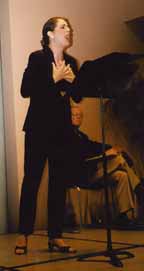 Four singers, Karin Paludan, Paul McCilviane, Daria Gerwig, and Lewis Freeman, are on stage, having had one joint rehearsal the night before with their singing coach Gillian Cookson, the artistic director of Encompass New Opera Theatre Nancy Rhodes, composer William Banfield, and poet Karren Alenier.
Four singers, Karin Paludan, Paul McCilviane, Daria Gerwig, and Lewis Freeman, are on stage, having had one joint rehearsal the night before with their singing coach Gillian Cookson, the artistic director of Encompass New Opera Theatre Nancy Rhodes, composer William Banfield, and poet Karren Alenier. 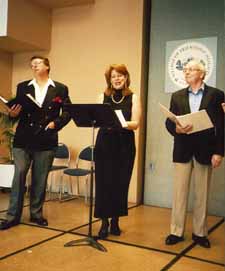 Ms. Rhodes provides the artistic directions to the singers an hour before the performance
Ms. Rhodes provides the artistic directions to the singers an hour before the performance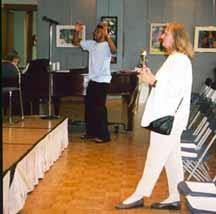 .
. 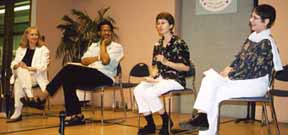
Over 150 people in late July, including a well-known music critic (Joseph McLellan), show up for this performance of five songs taken from act one of Gertrude Stein Invents A Jump Early On. A panel discussion with audience participation moderated by the veteran poetry-talk-show radio host Grace Cavalieri reveals that the audience is excited about what they have just heard.
Behind the Scene: The Poet & The Realpolitik
How did this first workshop performance come about? The poet convinced the following people and organizations to participate:
- The composer, who had to travel from St. Paul, Minnesota, and at the last minute figure out where to get singers when the poet’s scheme for singers fell through.
- The artistic director, representing Encompass New Opera Theatre which co-commissioned the project. Ms. Rhodes had to travel to DC from New York City and trust that the chosen singers could perform the work.
- Friendship Heights Village Center which had never before hosted an opera workshop but based on other programs the poet had produced at the Center, including a poetry slam that drew over 150 people, agreed to host the event and provide a small monetary stipend.
- The panel moderator, who as a playwright, poet, radio show producer, teacher, publisher keeps a schedule that is tightly booked and she lived at that time in West Virginia.
- The Montgomery County, Maryland Arts Council, which provided a small grant to help pay the singers but not cover the travel costs for the composer and artistic director.
- Two friends of the poet who provided overnight accommodations to the composer and artistic director.
- A local restaurant, which provided complimentary dinners after the performance to the composer and artistic director.
Additionally, the poet had to make sure sufficient notice went out to the public about the event. Through The Word Works, the co-commissioner with Encompass New Opera Theater, fliers were designed (this is about having a personal relationship with the resident artist) and news releases created. The poet distributed these notices to newspapers and personally traveled around the Washington, DC area handing out and hanging up the flier where people interested in poetry, opera, and Gertrude Stein might read about the event. The poet had about two weeks to get the word out because the singers were not in place until that time.
Venturing into Never Never Land
Seasoned veterans of theater might be asking at this point, what was the urgency and why take such a risk? A metaphor that leaps to mind is Peter Pan prompting the audience to shout I believe to get Tinkerbell’s life light beaming again. If you look at the time line of Stein opera activities (see Introduction at www.steinopera.com), you might note that project fundraising began in 1999. Most of the contributors to this project are individuals, many of whom live in the Washington, DC area. However, I had been talking about the project as an opera since 1997.
Unlike Virgil Thomson who promoted Four Saints In Three Acts by inviting wealthy people he knew to hear him play and sing the music and words at available living room pianos, I don’t have a list of power brokers who will invite me into their mansions and open their purses. The people who have contributed to this project are folks of modest means so their dollars, however small, are well considered before they are given. Believe me, I have tried to form an Ivy League connection but I need a sponsor to introduce me.
Stir into this mix, the participation of my two collaborators who became aware of the project in August of 1998. To keep the interest, let alone excitement, we all needed to hear what the early music out Bill’s pen sounded like. If one leaves a fire burning without throwing on new logs, what happens?
It was not just proof of concept that I had in mind, but giving back to the individuals who believed in this project and the poet behind it. Another important benefit of this workshop was the bonds created between the collaborators as we struggled to make this first workshop performance happen. I think I’m not taking too much of a risk by saying now that it took our artistic director two years after this event to make her believe that the high energy enthusiasm demonstrated by our first audience might be repeated in New York where she believes higher standards are set and the critics, like the crocodile following Captain Hook, are eager to tear into the limbs of new work.
Whereas theater people drive out the demons by telling each other to break a leg, my great grandmother Pearl and her generation would rush forward at this point to spit on my upturned dress hem. Oops! Am I wearing pants again? To ward off the evil eye, I wear the Xamsa (hand of God) that I bargained for in Marrakech the year before Paul Bowles in Tangier helped me work out the rhythms of “Leo on Seesaw,” my favorite poem inspired by Gertrude Stein and now set to music in Gertrude Stein Invents A Jump Early On. We aren’t out of the woods yet with this opera. The artistic director has good reasons based on experience to hold back. And there are more struggles on the horizon and more people to convince and otherwise charm along this Steiny road to operadom.
©2003 Karren LaLonde Alenier
|
Karren LaLonde Alenier, an award-winning Lindy Hopper,

is the author of five collections of poetry,
including Looking for Divine Transportation,
winner of the 2002 Towson University Prize for Literature.
Much more at www.steinopera.com
For prior installments, click here

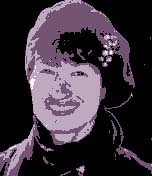
A Travelogue Pastiche of the Work-In-Progress Opera:
Gertrude Stein Invents A Jump Early On
© 2003 AVIAR-DKA Ltd. All rights reserved (including authors’ and individual copyrights as indicated). All copyrights, trademarks and servicemarks are protected by the laws of the United States and Internalnational laws. Reproduction in whole or in part without permission is prohibited.
For permissions, contact publishers@scene4.com
All articles are archived on this site.
To access the Archives

SEPTEMBER 2003
